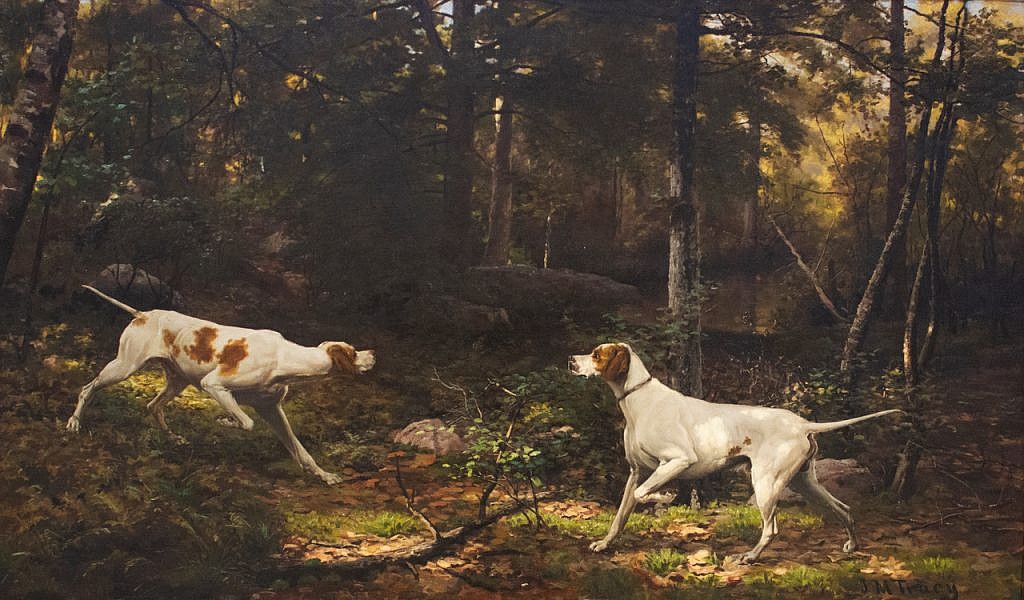
by Brooke Chilvers
The American Kennel Club Museum of the Dog, now returned to its original location in New York City from St. Louis, recently acquired an important work by John Martin Tracy: Haunt of the Woodcock: Sensation and Bang Bang.
Works by John Martin Tracy (1843–1893) of field trials with hounds and gun dogs, and upland shooting, are not easy to come by. The artist turned from portraiture to sporting art late in the career of his too-short life. He died while on the road, seeking commission work in the South, as usual, dying in Ocean Springs, Mississippi at age 49. Just before, his five paintings due to be hung in the 1893 Chicago World’s Fair were lost in a fire.
Tracy’s birth was tainted by his father dying before he was born in Rochester, Ohio, in 1843. An abolitionist preacher, he was murdered by an angry mob at an anti-slavery demonstration. Tracy’s suffragist mother, with three children to support, became one of America’s first female journalists, at the price of turning the kids over to her own mother. One of his parents was a Mayflower descendent.
Tracy had been attending Oberlin College and Northwestern University when the Civil War broke out. He joined the 19th Illinois Infantry Regiment, serving as lieutenant.
After the war, he made it to the École des Beaux-Arts in Paris, then returned to Chicago, where he established a studio, and returned again to Paris. This time he learned to paint scenes from memory, married the sister of a well-known sculptor, and exhibited at the Paris Salon of 1874.
Moving to St. Louis in 1878, Tracy began painting commissions of gun dogs and hounds from America’s first field trials. In 1881, he settled in Westport, Connecticut, and continued painting in the tradition of A.B. Frost and A.F. Tait.
Jeana Wunderlich of the Museum of the Dog writes, “His skill in capturing every element of the hunt—the glorious natural setting, the dynamic activity, the vitality of man and beast, the majesty of finely bred champion dogs and horses, and the revered dignity of the sport—soon catapulted him to the forefront of that specialty.”

The painting, acquired in 2020 by the Museum through the generous donation of Westminster Kennel Club (WKC) emeritus governor Sean W. McCarthy, depicts the pointer Sensation. Sensation had been chosen by a member of the club to be the breeding stud for their recently formed kennel and club, which would devote itself to the breeding of pure lines of dogs. Established in the 1870s, the club was named after the hotel bar of their favorite Manhattan gathering spot.
Sensation was previously named “Don,” and had won first place at Shifnal and Swansea, and second at Llanelly and Newport, among others. He seemed the right stud to travel to America, where he would earn the club $50 a round, equivalent today to more than $1,000. Not to be forgotten is that Sensation was also registered in the very first volume of the stud book of the National American Kennel Club, today’s AKC.
Sensation was so sensational that his image has served as the mascot and logo of the WKC nearly every year since 1877.
Bang Bang was perhaps a little less prestigious, although his grandparents had been owned by the Earl of Sefton, “whose grounds held the famous Greyhound coursing meet, the Waterloo Cup,” explained Wunderlich.
In another Tracy painting in the collection, Open Season, the portrayer mostly of English setters this time depicts an Irish setter against a rough field of cut and stacked corn. It looks like this may be a quick study, done in a day’s work, “rather than full-blown paintings he put his whole heart into,” writes Wunderlich. “The figure in this piece doesn’t have the detail or defined musculature that Sensation and Bang Bang does, and the dog’s expression is more cartoonish. The background is more slap-dash, as opposed to the dappled forest that contains depth and detail in Haunt of the Woodcock.”
You can visit the American Kennel Club Museum of the Dog in person or search its permanent collection of 1,700 works online. The museum is located at 101 Park Avenue, halfway between the United Nations and the Empire State Building, in the very attractive Murray Hill section of Manhattan
______________________________________________________________________________
Brooke Chilvers also recommends a virtual visit to the museum, led by Alan Fausel, Executive Director of the Museum, who may be familiar from his appearances on the Antiques Roadshow. Go to YouTube: AKC Museum of the Dog Video Tour with Alan Fausel.
